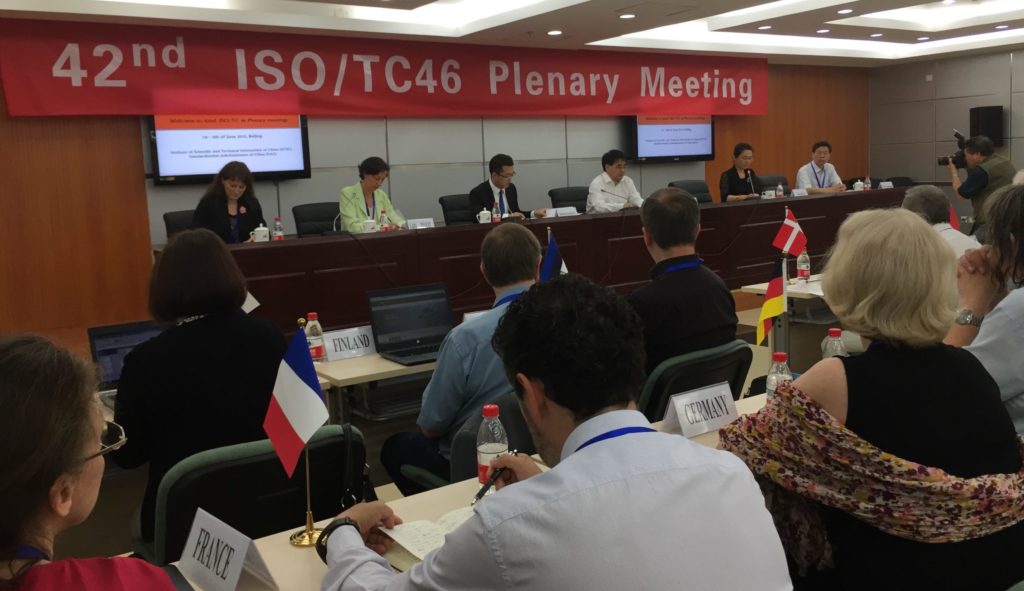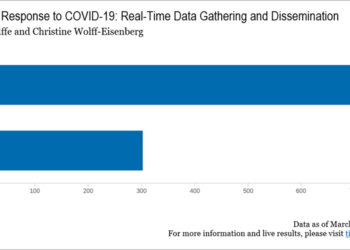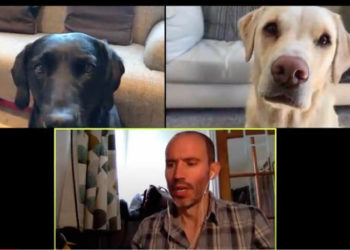As we enter the third month of a COVID-19 working environment, we have all become somewhat accustomed — if somewhat bridled — by the virtual work and school situations we face. Organizationally, a lot of what the National Information Standards Organization (NISO, I am the Executive Director) did “before” (as my staff has come to refer to the pre-COVID times) was organize people to work on projects and help guide them toward consensus. Most of that work took place virtually. The majority of our team worked from home offices spread out around various locations already, so from a work perspective, much of what NISO does hasn’t changed because of the lockdown that we all are experiencing.

But there are times when we do get together for concentrated work. Last week the NISO community was meant to meet in London for the annual plenary week of ISO’s Technical Committee on Information and Documentation (ISO TC 46) and its various subcommittees and working groups. The meeting brings together a few hundred experts in various publication, library systems, and standards development areas; our primary tasks are to report on work done throughout the year, plan for work in the coming year, as well as accomplish specific project-related tasks in-person where communications can be direct.
While we are adept at getting work done virtually, since that is how we accomplish things within ISO for the other 51 weeks a year, there is a significant difference between what can be accomplished in-person versus online. I’m sure anyone reading this will recognize this feeling. During a concentrated half day of in-person time, a team can accomplish significantly more than the same amount of time spread over a couple weeks or months of virtual one-hour meetings.
As someone who previously spent several months a year in aggregate on the road at various publisher, library, or software meetings, I am also cognizant of the lack of opportunity during an online meeting to take someone aside for a “hallway conversation.” There are often threads of a particular topic that need to be discussed, but aren’t of interest to the larger group or are made up of details which needn’t be laid on the table for all to see for whatever reason. It’s one of the many benefits of in-person social interactions that are missing in our world right now. The inability to have a side conversation — even in whispers with the person next to you during a meeting — is problematic. In an in-person situation, just a knowing glance with your friends or colleagues can often suffice for connection and agreement. A WebEx or Slack chat simply doesn’t cut it. This is particularly the case in forums where everyone’s native language isn’t English. One of the things that is missing, especially when working across languages, is face-to-face interaction and the ability to read a person’s mannerisms in order to more fully understand what they are communicating.
I certainly want to get back to a world where we can exchange thoughts with each other and interact in person and, in many cases, be more productive through group work that isn’t based solely on online interactivity tools. There is also the industry awareness and common problem-solving that we find when discussing problems together. Similar to how we appreciate serendipity of search when we browse the physical stacks of a library or bookstore, we would all benefit from finding ways in this current distanced, online environment to share thoughts, experiences, or problems in more unstructured ways. This comes naturally in person, but feels forced, if not impossible, when our days are structured with routines, interspersed with personal/family responsibilities and interactions, and planned bouncing from teleconference to virtual meeting to webinar all day.
All this rumination brings me to the announcement that Digital Book World (DBSW) will move forward with its planned annual conference in Nashville in September. This decision by the leadership of DBW has me flummoxed. Canceling a meeting has to be heart-wrenching for any group. As an organization that was able to hold one of the last in-person meetings at the end of February before the lockdowns descended, NISO was extremely lucky in many respects. We didn’t have to go through the difficult process of deciding to cancel an in-person meeting at the last minute with all the attendant costs. We didn’t have to scramble to move our event to a virtual footing at the last minute as others have done. Many organizations also had to struggle through the financial nightmare of managing cancellations and the impact these have on their fiscal situation.
Conversely, DBW, having made the decision to continue as an in-person conference, has posted its health and safety policy on its website. DBW leadership has taken the approach that they will arrange to have, “a trusted healthcare partner” test each attendee upon arrival, with the testing cost included in the registration fee. All attendees who test negative will then be allowed unfettered access to the conference, without any additional mitigation protocols. Anyone testing positive, will be immediately dismissed. I am not an epidemiologist, nor will I offer my opinions here on the various problems, issues, or risks to participants’ health that this approach might involve (although I have lots of them!). I’ll leave it to you to consider your own views about this approach to organizing a major industry conference.
What gives me pause was our own experience after the NISO Plus conference ended. Two weeks after the event, we received information that one of our attendees was suffering from COVID-19 and in the hospital. There was some concern that this person had been infected through participation in our conference; although upon reflection, though not obvious at the time, it was probably not likely given other circumstances. After getting over my own personal panic attack reflecting on my own possible exposure and how I might have passed it onto my family, I sat down and drafted a letter to the conference attendees. “Out of an abundance of caution,” it started. The letter went on to convey the basic details and suggested people take special note of any potential symptoms. Because of their (or their relatives’) compromised health conditions, several participants responded quickly to request more information about the identity of the person, which I was not in a position to provide. It was a difficult, heavy situation, and in early March, it was a harbinger of the many complicated issues that our larger society would face in the subsequent weeks.
Many scholarly publishers and librarians belong to organizations that also host conferences, meetings, and more informal in-person interactions of various sorts. Conferences are a core venue where scholarly information is shared. As such, the scholarly communications community needs to reflect on the future of these events, either in-person and/or virtual. It is difficult to know how to plan for something so far ahead. Because of the COVID-19 virus, the planning window for our lives seems to have been narrowed to at best a few weeks out, rather than the months or years that conference organizers normally operate within. Every long-term plan is made with the caveat, “Well, it all depends on what happens with the virus…”
Without any prophylactic or post-infection treatment, large in-person meetings carry a not insignificant risk, which would cause me — for one — to avoid participation; many others, I expect, would avoid them as well. Still others might see the risks as not so great and be more ready to assume them. Which group is in the majority, it is too soon to tell. However, we are beginning to see this play out all over, in varied circumstances, where people who have different perspectives on risk take different actions. Again, while I’m not a virologist, some of the DBW-proposed actions seem to defy common knowledge about the communicability of this airborne virus. Even with ubiquitous testing of meeting attendees, certain characteristics of the COVID-19 pandemic, such as its ability to be spread from asymptomatic carriers, or the potential of false negatives from testing, should raise concerns about the DBW approach. Even these measures would not prevent those attendees from interacting with — and potentially being infected by — others, such as the staff of their respective hotels, or the staffs of the restaurants, the airlines, and on and on. This is a much wider societal problem, not an issue with testing at a single meeting. There are a lot of unknowns at this stage. It will be interesting to see whether something like attending a professional conference is considered essential enough for participants to take the risk. For many people today, it seems as though even venturing in-person to a grocery store for food seems too great a risk. Again, hopefully by September, sufficient time will have passed for these risks to have moderated somewhat.
If the current situation continues — or improves and then worsens again — meeting organizers will need to reconsider how to approach conferences. Much like the online articles of the 1990s, virtual events over the past several years have sought to simply replicate the classroom experience of a person presenting to a virtual audience, who are envisioned to be sitting in their seats watching the talk. But this scenario isn’t, and never was, what really took place at a conference. Even the simple act of being able to look around, share a glance, pass a note, or whisper to a colleague about the talk is lost in our online meetings right now. The hallway conversations are missing. Wandering the exhibit halls, finding and talking with potential partners, being introduced to colleagues of friends, or even other colleagues from other divisions of one’s own company, can’t readily happen in a virtual meeting environment – at least not in the way we are currently using them. I am aware that some companies are exploring new technological approaches. My own team is studying what we might learn from and adapt from various online pedagogy experiments. Some companies are even promoting their services in teaching people how to organize more engaging online events.
Much like the digital article produced today typically includes much more functionality than that of the PDF article from the 1990s, what extra opportunities will the virtual event of the future support? What will it mean to be a born-digital conference? Whatever happens with the pandemic, there will be a lasting impact on the conference world from this experience. From my perspective, I’m looking forward to something that is more than three days of live online PowerPoint slides.
Discussion
5 Thoughts on "What We’re Missing From Being in Person, or, What Will a Born Digital Conference Look Like?"
I couldn’t agree more. The move to digital conferences feels like a continuation of the process of professionalising and streamlining conferences that has been happening over the past 20 years, with the increasing use of extremely expensive exhibit service companies…. granted it’s nice to turn up from the airport and find the box with the scissors in it has already been delivered to your stand, but I wonder how much camaraderie has been lost in not having to band together with colleagues from other businesses for a mission to the depths of the hotel’s mailroom….. I’d love to see ideas on how to replicate that in digital format!
The opportunity to build relationships seems to be missing from online meetings. Some of that comes from camaraderie, but it goes farther. Catching up with each other on our personal lives as well as sharing needed and valuable professional information is an important part of in-person meetings. Connecting with colleagues is often as important as attending sessions. If you work for a membership society, connecting with your members is a key component of your annual (in-person) meeting.
Speaking solely for myself, I welcome the move to online programming and have felt this way for several years after, well let’s just say a long time of attending, speaking at, developing, and running conferences and events.
There’s a quip in the book publishing industry that, no matter how well a book sells, the shipping companies always make money from books going out to market and then coming back as returns. Digital solves part of that problem so perhaps there is an analog in the online conference business? Save the travel money shipping attendees back and forth and invest in the content and user experience?
And, hey, vendors can still send us the swag if they really want to spend on shipping.
There is no doubt that the present crisis is provoking some hard thinking and rapid innovation by conference organisers. There remains massive uncertainty about how this pandemic will play out, and what changes in behaviours will emerge and persist. Some changes will, I think, be natural developments in a path of technological innovation that has been going on for centuries, if not millennia, such as video-conferencing tools. Some changes will be knee-jerk reactions that will quickly fade into history, like the red-flag man preceding an automobile. Some will be gambits that look like desirable innovations, but turn out to be tiresome barriers to effective communication, or interim technologies, like the fax machine. And worst of all some will be strange artefacts that we somehow can’t eliminate, like confiscating penknives from air travellers starting from the very moment that successfully hijacking an airliner with a penknife became impossible.
Conference organisers are also managing events that are at different moments along the information and innovation line. NISO PLUS, like my own event, R2R, just managed to avoid the onrush of the pandemic this year, sharing an (unfortunate) overlap of dates. Many events in March and April were swiftly cancelled, or rather crudely turned into online ‘broadcasts’. Events in the summer are scrambling to offer a more impressive digital broadcast experience. But an event scheduled for the autumn, like DBW or Charleston, has to make a difficult bet on going online or staying ‘in real’ (as my gamer sons used to say), and I applaud DBW’s bold (rather medicalised) approach, and really hope this works on a practical level. And I hope that delegates are, by then, willing and able to attend. But I also hope they have an online contingency plan.
It is my confident belief that people will, for many of the reasons Todd has eloquently expressed, want to get back to attending face-to-face events as soon as they feel safe and confident. The only issue for me is whether this can happen as soon as Autumn 2020, or might take months (or years) to become both medically and psychologically acceptable.
https://www.researchinformation.info/analysis-opinion/will-one-epidemic-overturn-200000-years-social-evolution
My own Researcher to Reader Conference is currently making plans for a hybrid (online and live) event in London in February, but we will need to be flexible as the pandemic unfolds and attitudes develop. I’m hoping that by then, people who recognise that life is full of risks, many of them very quantifiable, will be willing and able to attend in person, be we also aim be able to enjoy the unique R2R conversation with those for whom ‘an abundance of caution’ is a preferred approach.
https://thegeyser.substack.com/p/interview-mark-carden-r2r-conference
Great article; but I think Todd is missing an important point: there is a difference between the kinds of NISO activities that Todd cites and what goes on at DBW. DBW is a trade show; NISO activities are working group meetings. Well, there are many differences, but the main one for these purposes is that generally everyone who schleps to a NISO working group meeting wants to be there, while many people who go to (and particularly exhibit at) trade shows do not.
Much of the trade show business is propped up by vendors going there for FOMO or FCBT (Fear that our Competitors will Be There) or FBPL (Fear of Being Perceived as Losers). Trade show booth sales people prey on this fear by, for example, hard-selling vendors on the show floor during one year for the next year. I’ve seen this as someone who has bought and managed trade show booth space, run a small niche conference, been on the advisory board of a major trade show, and of course attended many types of industry gatherings. On an online forum for publishing folks recently, when the announcement that a large book industry trade show was being cancelled made the rounds, the first words out of everyone’s keyboards were variations on the theme of “Yay.”
I tip my hat to Bradley Metrock for his persistence, as well as his success in resurrecting a moribund trade show over the past few years. But I think he’s going to find the future tougher than he suspects, and not just because you have to have your temperature taken or wear a mask every day when you walk into his venue this September. Meanwhile I have no doubt that Todd’s NISO working group meetings will bounce back fully, and I’m pondering the future, if any, of my own Copyright and Technology Conference.



